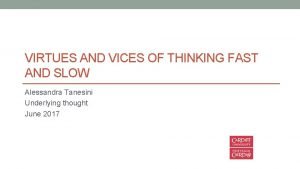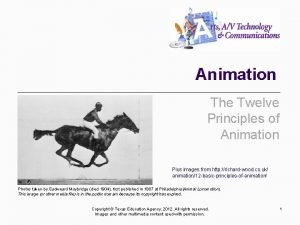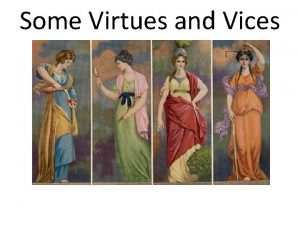VIRTUES AND VICES OF THINKING FAST AND SLOW










- Slides: 10

VIRTUES AND VICES OF THINKING FAST AND SLOW Alessandra Tanesini Underlying thought June 2017

Fast and Slow 2 Take home messages • The psychological underpinnings of (at least some) intellectual virtue and vices are plausibly identified as attitudes (as these are understood in social psychology). • This psychological framework when applied to intellectual virtue and vices has several benefits. Here I highlight three: • (A) it provides an answer to the situationism challenges; • (B) if offers a common framework through which to understand vice epistemology and implicit bias; • (C) if offers a way of thinking about the virtues and vices of deliberative reasoning (slow thinking) and intuition or gut feeling (fast thinking).

Fast and Slow 3 Attitudes • Attitudes are summary evaluations directed at a target object. They can be thought as preferences, as likes or dislikes. They are cognitive shortcuts. (Banaji and Heiphetz 2010). • Attitudes have: • Objects • Contents • Strength • Functions (Knowledge, Ego-defensive; Social Adjustive, Value expressive) • Attitudes are measured explicitly through self-reports or implicitly by means of IATs or other similar tests. These may measure the same underlying states.

Fast and Slow 4 Strong Attitudes have the formal features of virtues • They are often thought by psychologists to be enduring dispositions similar to personality traits from which they differ primarily because attitudes have objects and are always evaluative (Sherman and Fazio 1983; Ajzen 1987). • They are: • Action guiding (predictive of behaviour) • Stable across different situations and over time • Reason responsive in so far as they are internally consistent including consistent with • • attitude-relevant conscious beliefs Capable of updating in light of the evidence (e. g. , persuasive messages and new experiences) Direct visual attention Have an affective/ emotional component Have characteristic functions (akin to motivation)

Fast and Slow 5 Situationisms • A. Human cognition is too variable depending on situations to be predicted by any psychological feature that is stable over time and sufficiently distinctive of the person to count as part of their character (Doris 2002). • Strong Attitudes are stable, distinctive • B. Human cognition is too sensitive to epistemically irrelevant (non-reasons) situational variations (Alfano 2013). • Moods are not epistemically irrelevant

Fast and Slow 6 Situationisms • C. Human cognition is naturally vicious. Both fairly automatic processes and complex ones are highly sensitive to situational features which are epistemically irrelevant (in the sense of evidentially irrelevant). Therefore, these processes are likely to be unreliable (Olin and Doris 2014). • The heuristics literature does not support such unqualified negative conclusions (Gigerenzer and Todd 1999; Bishop 2000). • The specific examples offered by Olin and Doris are flawed • fluency as a proxy for validity (Reber and Unkelbach 2010). • embodied perception (e. g, if slant is measured in units of effort, the same hill is steeper for an older or encumbered individual than it is to a younger or unencumbered one. (Bhalla and Proffitt 1999; Witt et al. 2005; Witt and Proffitt 2005)

Fast and Slow CAPS • CAPS as an answer to situationist challenge in psychology • Fragmentation is the philosophical challenge • CAPS has no answers 7

Fast and Slow 8 Metacognition • Some virtue epistemologists have taken the lesson of the situationist challenge to be that intellectual virtue must require the taming of type 1 (automatic fast) processes and the development of hyper-vigilant type 2 (rational, conscious) processes (Roberts and West 2015). • Continence not virtue • Attitudes can regulate cognition in more than one way: • For example, those whose attitudes are ego-defensive • Are more vigilant for threats (but also suffer more false positive) (Haddock and Gebauer 2011) • Scrutinise more carefully messages that speak to that concern than messages that speak to other concerns • Prefer to employ some styles of thinking toward which they have positive attitudes formed because of the ability of these styles to combat threat • Engage in cognition motivated by the goal of defence (for this kind of goal driven cognition see Chaiken et al. 1996) • In short attitudes can be seen as regulating both type 1 and type 2 processes. Virtues need not be thought as type 2 (conscious, voluntary, inferential) processes which intervene to replace type 1 (automatic, unconscious, heuristic) processes

Fast and Slow 9 Responsibilist virtues and vices, motivated cognition, heuristics and inferential reasoning • Virtues such as intellectual humility as explicit attitudes toward self and one’s cognitive capacities which are strong and serve knowledge function (Tanesini 2016 b). • Accuracy driven cognition • Vices as explicit attitudes toward self and one’s cognitive capacities which are strong and serve functions such as ego defence and social adjustment. • Arrogance as positive strong explicit attitudes toward the self and one’s capacities serving ego-defensive needs(Tanesini 2016 a and unpublished). • Defence driven cognition (Chen et al. 1999)

Fast and Slow 10 Attitudes and Implicit Biases • Implicit biases are often thought to be a subset of implicit attitudes which have social groups • • • as their objects (Greenwald et al. 2000; Banaji and Greenwald 2013). Implicit and explicit attitudes can be congruent. Individuals who have strong defensive attitudes and engage in motivated cognition should also exhibit implicit biases that are supportive of their attitudes as explicitly measured. Attitudes can also be discrepant and their discrepancy signals a lack of virtue and possible presence of vice. Webber (2016, pp. 134 -6 and 145 -6) identifies a common ground to the problem of situational manipulation and the phenomena described as implicit biases. He describes the problem as one of fragmentation. In such cases weak attitudes are formed on the hoof based on false beliefs about how one performed in IAT test and thus misconstruing one’s attitudes are revealed by the implicit measures. An alternative account accepts that explicit attitudes can be strong and consistent with consciously held beliefs and other attitudes as explicitly measured and nevertheless inconsistent with implicit attitudes. These discrepancies and fragmentations would be one of the ways in which a person can be intellectual vicious.
 Virtues and vices are attitudes. what are their objects?
Virtues and vices are attitudes. what are their objects? Theological and cardinal virtues
Theological and cardinal virtues Slow in slow out animation
Slow in slow out animation The seven vices
The seven vices Fast twitch and slow twitch muscles
Fast twitch and slow twitch muscles Fast clock to slow clock synchronization
Fast clock to slow clock synchronization Opposites fast
Opposites fast Example of acid-fast bacteria
Example of acid-fast bacteria Non acid fast bacteria
Non acid fast bacteria Positive thinking vs negative thinking examples
Positive thinking vs negative thinking examples Thinking about your own thinking
Thinking about your own thinking


















